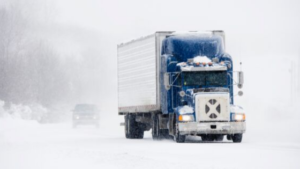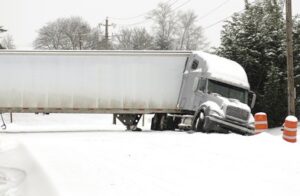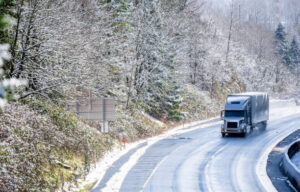



Any Professional Truck Driver will tell you that winter driving can be scary and downright dangerous sometimes, which is why it’s critical to stay prepared during the winter months and to stay informed. Winter driving is dangerous for everyone, especially if you’re hauling thousands of pounds of cargo up and down mountains and roadways. No matter how experienced you are as a Professional Truck Driver, winter driving always presents a unique set of challenges that you need to prepare for if you want to safely navigate your equipment along the snowy, icy roads of your route. Here are more tips that will help you accomplish that task during winter driving and beyond.
Recent News
-In Faribault, Minnesota in a recent winter storm on Dec. 10, 2021, in just over 24 hours the Minnesota State Patrol reported over 286 accidents with over 21 of them being jackknifed semi-trucks.
-Also in Minnesota one truck completely blocked off a portion of I-35 during these same storms.
-One man from Tennessee who has been driving through the same routes in Wyoming for over 35 years as a Professional Truck Driver recently got caught in a winter storm, causing him to roll his truck. During the accident, his road companion, a dog named Yogi, went missing and now has been lost for over a week.
-Just days ago on Dec. 16, 2021, near Spokane, Washington, multiple semi-trucks were reported to have slid and jackknifed due to the icy conditions.
How to Handle Dangerous Roads and Weather Conditions

Know up-to-date weather information before you begin your trip, and be informed of closed routes and changing conditions via GPS systems, radio, or by calling your dispatcher, fellow drivers, and the local D.O.T. for the areas you’ll travel. This is where telematics may be of enormous assistance in determining where drivers are, the routes they are traveling, and the chances to identify alternate, safer routes. Remain in constant contact.
Winter driving can be dangerous in and of itself and there are two specific dangers to be aware of:
In near-freezing weather, keep an eye out for signs of black ice on the roadways. Black ice is a dangerous road condition that appears as a thin layer of clear ice that frequently makes the surface appear slightly damp. The following are warning signs indicating you are driving on black ice:
It is critical to ensure that you have the proper equipment before embarking on your adventure, especially during the winter season. Make sure you are ready to deal with any emergencies that may arise and that you have the following items on hand:
When it comes to pre-trip inspections during the winter months you’ll need to modify your inspections significantly. Not having sufficient tread depth on your tires, or having brakes out of adjustment can cause the truck not to stop properly and safely.
You should always double-check your:
While on the road, be sure during stops to clean snow off the tractor and trailer, especially the lights, reflectors, and turn signals.

The majority of accidents occur as a result of drivers traveling too fast, distracted driving, etc. When stepping behind the wheel of an unknown truck, take your time to get familiar with the vehicle and its functions, and remember that it is much more difficult to control or stop on a snow-covered road!
Be sure to increase stopping distances, avoid sharp movements that can cause you to lose control, and also forceful acceleration and braking which can also reduce traction. Maintain a continuous, steady speed and use caution when stopping – by maintaining a good following distance of about 6 seconds between yourself and the vehicle in front of you (adding a second for every other hazard on the road), you will always have a comfortable braking distance in icy conditions. Driving too fast or using cruise control or the engine brake in these conditions can significantly increase the chances of a jackknife or loss of control. Going 2-3 miles per hour slower than the flow of traffic is always good advice in these conditions, and before entering ramps, turns or curves, slowing down 10-15 miles per hour or more below the posted speed limit based on the situation helps avoid rollovers.
Be sure you are alert, not fatigued (or on medication that makes you drowsy), and dressed in warm enough clothing to not be distracted while driving. Be sure you are hydrated and not eating too heavy of meals that will induce fatigue. Snow chains can prove to be effective as they provide maximum traction in icy weather. Also, be aware of the fact when driving, the routes you take may seem narrower due to snow, and factors such as blowing snow, ice on windows, fog, and even snow glare can cause visibility issues. Wearing sunglasses and using the visor can help reduce this glare.
This may sound apparent, yet Professional Truck Drivers frequently fall and harm themselves by underestimating how slick their vehicle’s steps are. To limit the possibility of slips, falls, and injury, take your time and wear proper footwear for winter conditions. Also, remember to wear your high-visibility vest when visibility is low!
There is a good time and a bad time to pull over. When circumstances get so hazardous that driving becomes impossible, find a safe location to rest. If at all possible, avoid stopping/parking on the shoulder, as this greatly increases your chances of being hit. Instead, try to find a safer location to shut down.
Bottom Line
By being vigilant, cautious, smart, and always prepared, winter driving, although always dangerous, becomes a much less daunting task. Our goal is to get every Professional Truck Driver to their destination(s) and safely back home to their loved one(s) through the beautiful winter season for continued success.
